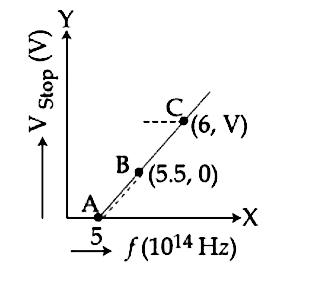Given figure shows few data points in a photo electric effect experiment for a certain metal. The minimum energy for ejection of electron from its surface is ejection of electron from its surface is : (Plancks constant h = 6.62×10−34Js)

A
2.27 eV
B
2.59 eV
C
1.93 eV
D
2.10 eV
Video Solution
Text Solution
The correct Answer is:A
Graph of Vs and f given (B 5.5 , 0)
hv=ϕ+eVs
at B Vs=0,c=5.5
⇒h×5.5×1014=ϕ
ϕ=6.62×10−34×5.5×10141.6×10−19eV=2.27eV
|
Similar Questions
Knowledge Check
The photoelectric effect is described as the ejection of electrons from the surface of a metal when
AIt is heatedBIt is placed in strong electric fieldCElectrons of suitable velocityDLight of suitable wavelength falls on itPhotoelectric effect is described as the ejection of electrons from the surface of a metal when:
Ait is heated to a high temperatureBlight of a suitable wave length is incident on itCelectrons of a suitable velocity impinge on itDit is placed in a strong electric fieldThe photoelectric effect is described as the ejection of electrons from the surface of a metal when-
AIt is heatedBIt is placed in strong electric fieldCElectrons of suitable velocity impinge on itDLight of suitable wavelength falls on it
The photoelectric threshold wavelength for lithium is 8000Å. Find the maximum kinetic energy in eV of the emitted electrons from the surface by light of wavelength 6000Å. Take h=6.6×10−34Js.
View SolutionWhat is the momentum of electron beam of wavelength 4Å? (h=6.62×10−34Js)
View SolutionThe work function of a metal surface is 4.2 eV. The maximum wavelength which can eject electrons from this metal surface is
View SolutionThe threshold wavelength for the ejection of electrons from the metal X is 330 nm. The work function for the photoelectric emission for metal X is (h=66×10−34Js)
View SolutionThe work function of a metal is 3.3×10−19J. The maximum wavelength of th e photons required to eject photoelectrons from the metal is (Take h=6.6×10−34Js)
View Solution
